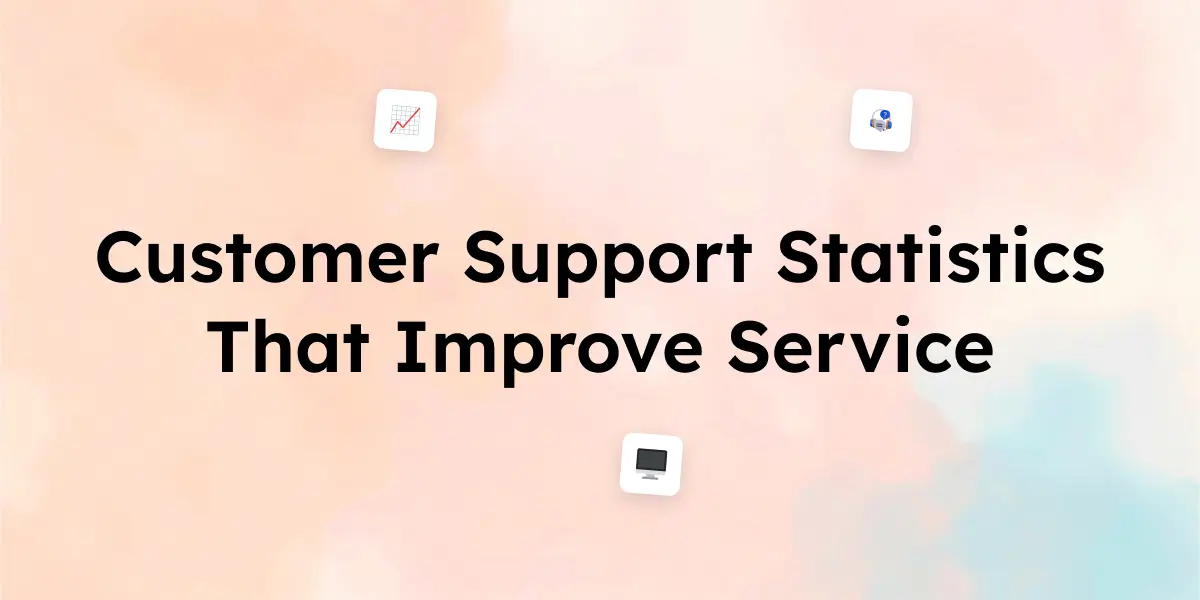Customer expectations are evolving rapidly, and in 2025, businesses must adapt to faster response times, AI-powered support, and seamless omnichannel experiences to stay ahead. Research shows that 73% of consumers will switch brands after multiple poor experiences, making customer service a key differentiator.
With advancements in AI, automation, and predictive analytics, companies can provide efficient, personalized, and proactive support like never before. But human touch still matters, as 35% of customers prefer speaking to a real person, even if it takes longer.
This blog explores 35 key customer support statistics that highlight emerging trends, efficiency metrics, and strategies to help businesses deliver exceptional customer experiences in 2025.
Customer Support Statistics for 2025
1. Customer Expectations & Satisfaction
- 88% of customers say the experience a company provides is as important as its products/services.
- 75% of customers expect faster response times than they did a year ago.
- 73% of consumers will switch brands after multiple poor experiences.
- 60% of customers say first-contact resolution is the most important factor in satisfaction.
- 85% of customers are willing to pay up to 25% more for a great customer experience.
2. Response Time & Efficiency
- 79% of customers expect a response within 24 hours on email and web support.
- 90% of consumers want instant responses via live chat and chatbots.
- 40% of businesses report that AI-powered chatbots reduce customer wait times by 30%.
- The average first response time for live chat is 45 seconds.
- Call center hold times longer than 3 minutes result in a 60% drop-off rate.
3. AI & Automation in Customer Support
- 60% of businesses use AI chatbots for handling routine queries.
- AI-powered support can resolve 80% of common issues without human intervention.
- Customer satisfaction with AI chatbots increased by 20% in 2025, thanks to improved NLP.
- Human + AI hybrid models improve customer resolution rates by 35%.
- 35% of customers say they prefer human support over AI, even if it takes longer.
4. Omnichannel Support & Communication Trends
- 72% of consumers expect brands to offer seamless support across multiple channels (email, chat, phone, social media).
- 85% of businesses provide omnichannel support, up from 60% in 2023.
- Facebook and Instagram DMs are now preferred by 40% of Gen Z for customer support.
- SMS-based support has 35% higher open rates than email.
- Voice assistants (Alexa, Google Assistant) handle 15% of customer inquiries in 2025.
5. Customer Retention & Loyalty
- Loyal customers are 5x more likely to repurchase than new customers.
- A 5% increase in customer retention boosts profits by 25%–95%.
- 70% of customers are willing to recommend a brand if they have a positive support experience.
- Personalized customer service improves loyalty by 40%.
- Fast issue resolution reduces churn rates by 30%.
6. Employee Performance & Training
- Companies that invest in agent training see a 20% increase in customer satisfaction.
- Happy support agents lead to a 12% boost in customer happiness.
- Employee turnover in customer service dropped by 10% in 2025 due to better work-life balance.
- AI-assisted agents handle 40% more queries per hour than human-only teams.
- Work-from-home support teams increased efficiency by 25% in 2025.
7. Future Trends in Customer Support
- Video support calls have a 20% higher resolution rate than phone calls.
- Self-service portals handle 60% of customer queries, reducing support tickets.
- Companies using predictive analytics improve customer experience by 30%.
- Sentiment analysis tools detect frustrated customers with 85% accuracy.
- Blockchain-based customer support ensures 100% data security, reducing fraud.
Key Takeaways for Customer Support Teams
✅ AI & automation enhance efficiency but human support remains essential.
✅ Fast, omnichannel support is a major factor in customer satisfaction & loyalty.
✅ Personalization & proactive support can reduce churn and improve retention.
✅ Investing in employee well-being & training directly improves customer experience.
Conclusion: Elevating Customer Support in 2025
s we move into 2025, businesses that prioritize speed, personalization, and AI-driven efficiency will lead the way in customer support. Happy customers drive loyalty, retention, and revenue, making it critical to invest in cutting-edge support tools and well-trained teams.
Here’s what customer support teams should focus on:
✔ AI + Human Hybrid Models → Boost efficiency & accuracy.
✔ Omnichannel Support → Meet customers where they are.
✔ Personalization & Proactive Engagement → Enhance loyalty.
✔ Agent Training & Well-being → Improve service quality.
By leveraging these insights and adopting data-driven strategies, companies can deliver world-class customer experiences that keep customers engaged, satisfied, and loyal.
FAQs
1. Why is customer support more important than ever in 2025?
Customer expectations are higher than ever, and 88% of customers say a company’s service experience is as important as its product. Providing fast, efficient, and personalized support helps businesses retain customers and drive revenue growth.
2. How does AI improve customer service efficiency?
AI-powered chatbots and virtual assistants can resolve 80% of common issues, reducing agent workload. AI also assists with predictive analytics, sentiment analysis, and self-service portals, making support faster and smarter.
3. What is the impact of omnichannel customer support?
72% of customers expect brands to offer seamless support across email, live chat, social media, and phone. Omnichannel support improves customer satisfaction, resolution rates, and brand loyalty.
4. How can businesses reduce customer churn with better support?
Fast resolution times, personalized experiences, and proactive communication reduce churn by 30% or more. Investing in agent training, AI-assisted workflows, and self-service options further enhances customer retention.
5. What are the top trends shaping customer support in 2025?
Key trends include:
AI-powered chatbots & virtual assistants
Hybrid human + AI models for efficiency
Predictive analytics for proactive support
Video & voice support adoption
Increased focus on employee training & well-being
Sources :
Salesforce State of the Connected Customer (2024-2025)
HubSpot Customer Service Trends Report (2024-2025)
Microsoft Global State of Customer Service Report (2024-2025)



